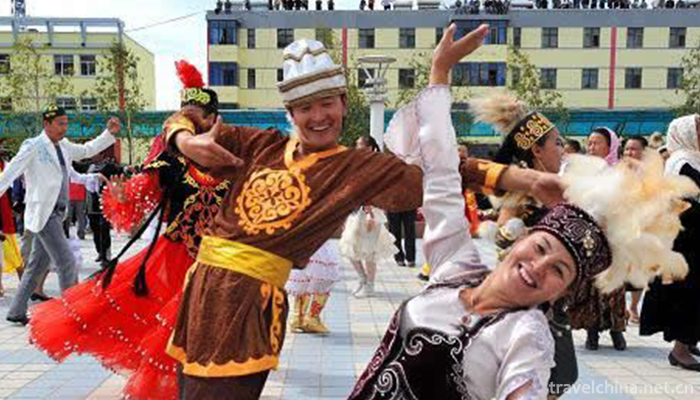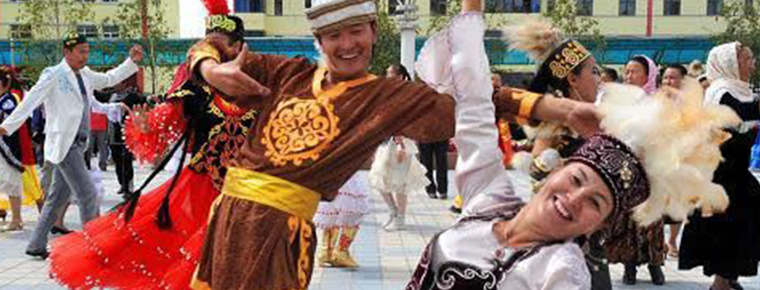Kazakh Karakol Leha
Kazakh Karakol Leha
Kazakh Kara Kolkha is a traditional dance of Kazakh nationality, which is spread in Yili, Xinjiang.
On May 23, 2011, Kazakh Karakol Kazakh was listed in the third batch of national intangible cultural heritage list with the approval of the State Council.
Legends of origin
Kalakolha is an ancient dance, about its origin, there is a legend in the Kazakh people: long ago, there was a Kazakh young man on the grassland, found a group of wild horses, he waved a rope to tie a very tough black wild horse. The young man went through all kinds of hardships and finally domesticated it into a good walking horse. When he returned home on a black horse, the villagers came to congratulate him on the news. The delighted young man danced and proudly and humorously simulated the whole process of capturing and domesticating the black horse with various movements. His vivid description and vivid performance made the villagers fascinated. Everyone listened to the young man's wonderful story and imitated his various movements of dancing and dancing. People immersed in joy danced and danced like this. Unconsciously, the people of the whole town jumped up with their own different dancing postures, imitating the action of the black horse. From then on, the Kazakh folk dance, which takes horse riding as the theme and expresses the vigorous posture of the steed galloping on the grassland, has spread.
Introduction to nouns
"Kazakh" is a Kazakh language, meaning "black walking horse". It was originally a simple body dance used by Kazakhs to imitate the walking, running and jumping postures of horses. It gradually evolved into a synonym of Kazakh folk dance. Performers often blend various movements with strong characteristics of labor and life into dance, making the dance content of "Kazakh" more abundant. Rich and diverse.
Style and characteristics
Karakol Leha: It is the most representative folk dance of the Kazakh people. Kazakh is Kazakh, meaning "black horse". The horse is an indispensable tool and partner in Kazakh life, and the "black walking horse" is the most important thing in the horse. It has a strong image, a bright black body, a steady and powerful walking pace, a graceful posture, and the sound of hoofs is like a clang drum. Riding on a black walking horse is like entering an artistic realm. People are dancing while horses are dancing. The male's movements imitate the walking, running, jumping and jumping postures of the black walking horse, and display a rugged, bold and bold style in a relaxed rhythm of the whole body. Women's movements are graceful, stretching, lively and implicit, such as showing the beauty and pride of the girl's "flower praise", peeping at the lover's "shy peep", looking forward and backward "skirt hanging flowers" and so on. These movements of men and women contain specific contents, which are integrated with the performer's inner feelings and humorous facial expressions, and can be freely developed according to the dancer's own level, constantly adding new contents and actions. Caracolla Leha is accompanied by music of the same name. This kind of music has a strong sense of rhythm, lively and lively, and its melody is like a steed galloping on the grassland. It is played by Dongbula, a traditional instrument of Kazakh nationality, and changes its rhythm according to the speed of dance.
Protection status
Since 1986, Kazakh Karakol Leha has been paid attention by professional groups, and its dance movements and music have been further improved. With the gradual implementation of the national policy for the protection of intangible cultural heritage, a project to excavate and protect the original ecological intangible cultural heritage is also in full swing throughout the state. Kazakh dance in Ili, which has a deep historical origin, cultural accumulation and broad mass base, has attracted the attention of the state, government departments at all levels and the public. "Black Walking Horse" was summoned from the quiet and remote mountains, and entered the vision of the broad audience, becoming a cultural wonder that integrates artistry and popularity.
On May 23, 2011, Kazakh Karakol Kazakh was listed in the third batch of national intangible cultural heritage list with the approval of the State Council.
Influence
In 2010, Karakol Leha entered the third batch of National Intangible Cultural Heritage Representative works. For a time, there was a rising "black-horse" fever in the urban and rural areas of Yili. Whether in the vast grassland with green grass, or in the plaza with laughter and laughter, or in the campus where the students seek knowledge and study, we can see the "black walking horse" dance posture which is light, vigorous, vigorous, graceful, stretching, lively and implicit. On August 30, 2009, 10,000 people danced together in Qinghe County, which set a world record of Guinness in Shanghai. In order to continue to carry forward Kazakh, a traditional fine folk art, and further strengthen the protection of intangible cultural heritage, Qinghe County decided to designate August 30 as the Kazakh "Kala Kok Leha Festival".
In order to carry out "student sunshine sports" extensively and ensure that students exercise for one hour every day, the education system of Xinyuan County takes Kara Korlaha as a highlight of school art education. During the big classes, students of all ethnic groups danced with the happy and smooth instrumental music and the bright melody of Kazakh. The huge lineup, magnificent momentum, exquisite dancing skills and graceful dancing postures make the rough, drastic, robust and bold style of the "black walking horse" vivid, vivid, incisive and shocking.
On January 26, the Autonomous Prefecture held a seminar in Calagorah. At the meeting, seven experts read out relevant papers, and the paper "Dance of History 2000" read by Asen Kumar of the Xinjiang Academy of Social Sciences aroused great repercussions. The old experts, such as Karimu Abdurehman, put forward their own views on the current situation and existing problems of Kazakh dance development, and appealed to everyone to excavate Kazakh folk dance represented by Kazakh Kolkha, absorb nutrients from the folk, create dances that accord with Kazakh people's aesthetic habits and life interests, and further enrich the dance vocabulary of Kazakh Kolkha. Music and lyrics.


-
1.Yin Ruins Scenic Area (Yin xu)
Yin Ruins, formerly known as "Northern Mongolia" , is the ruins of the capital city in the late Shang Dynasty of China, located in Anyang City, Henan Province
Time 2018-12-09 -
2.Jingming Hot Spring Resort
Jingming Hot Spring Resort is the largest resort in China. It is located in Jingxi Garden Town, Jiexi County, Jieyang City, Guangdong Province. It is built by Shenzhen Anyuan Investment Group Co., Ltd
Time 2018-12-22 -
3.The Great Wall of Water in Huanghua City
Huanghua City Water Great Wall is located in Jiuduhe Town, Huairou District, Beijing, 65 kilometers away from Beijing City. It is a famous tourist and leisure resort
Time 2019-01-18 -
4.Shenyang Science Centrum
Shenyang Science Palace is located in Wulihe Central Business District, Shenyang District, Liaoning Province. It is a large-scale modern popular science education base in Shenyang District. It was bui
Time 2019-02-08 -
5.Shui Guan the Great Wall
Shuiguan Great Wall is the eastern part of Badaling Great Wall. It was built at the mouth of dangerous valley. The Great Wall of Zishuimen Archery Tower is "V" shaped
Time 2019-02-13 -
6.Baoding old tune
Baoding old tune, also known as old tune bangzi, is one of the traditional operas with a long history in Hebei Province and a national intangible cultural heritage. At first, it was a popular Hexi tun
Time 2019-05-11 -
7.Mazu memorial ceremony
Mazu Festival, which originated in Song Dynasty, experienced Yuan, Ming and Qing dynasties and continued to expand and enrich. By the Qing Dynasty, Mazu was named "Tianhou", and the title re
Time 2019-05-15 -
8.Quanzhou breast clapping dance
Breast-clapping dance, also known as chest-clapping, seven beats, flower-clapping and beggar dance, is a traditional dance originating in Quanzhou, Fujian Province. It is widely spread in Quanzhou cou
Time 2019-06-11 -
9.Brewing Techniques of Shaoxing Yellow Rice Wine
Shaoxing has a long history of brewing wine, which can be traced back to the Spring and Autumn Period and the Warring States Period. By the time of the Northern and Southern Dynasties, it was well-kno
Time 2019-06-14 -
10.Rongxian Giant Buddha
Located in the eastern suburb of Rongxian County, Sichuan Province, the Giant Buddha of Rongxian county is carved in the Tang Dynasty. It is a cliff carved statue of Sakyamuni, 36.67 meters high, 8.76 meters long, 12.67 meters wide, 12 meters high and 3.5 meters wide. It is the world's largest Sakyamuni Buddha (Modern Buddha).
Time 2020-10-15 -
11.Administrative division of Guangyuan
Guangyuan City has 7 county-level administrative divisions (Municipal District 3, county 4) and 142 township level administrative divisions (Street 7, town 111, township 24). It covers an area of 16310 square kilometers and has a population of 3.11 million. Guangyuan Municipal People's government is located at No.24, north section of Renmin Road, Lizhou district.
Time 2020-12-15 -
12.Nanchong mineral resources
Nanchong mainly has rock salt, oil and natural gas, placer gold, ferrotitanium, uranium, phosphorus and other mineral resources. Nanchong is located in the core of Nanchong rock basin, the largest rock salt sedimentary basin in Sichuan Province. Underground
Time 2020-12-17